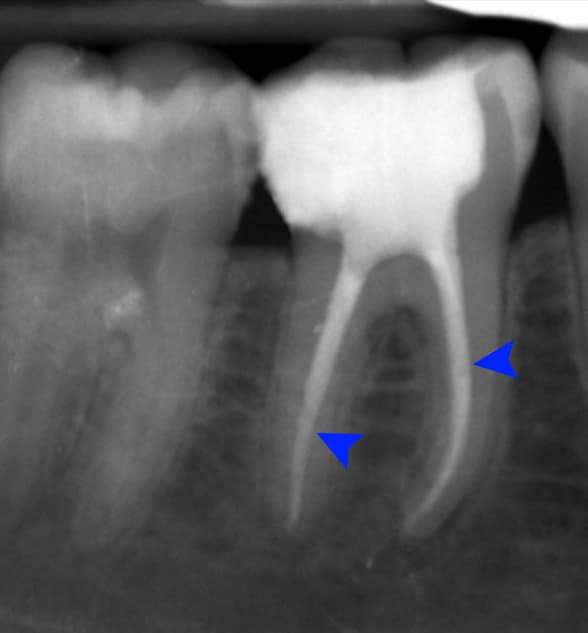A “root canal” is not a treatment, but part of a tooth. It is the hollow section of a tooth that contains the nerve tissue, blood vessels, and other cells, also known as the pulp. A tooth consists of a crown and roots. The crown is mainly above the gum, while the roots are below it. The roots attach the tooth to the jawbone. Inside the crown and the root, or the root canal, is the pulp. The pulp nourishes the tooth and provides moisture to the surrounding material. The nerves in the pulp sense hot and cold temperatures as pain. The name of the dental procedure commonly referred to as a “root canal” is actually endodontic therapy, which means “inside the tooth.”
What are the steps?
Root canal therapy is done in three steps, and it takes between one and three sessions to complete.
1. Cleaning the root canal
First, the dentist removes everything that is inside the root canal. With the patient under Local Anesthesia, the Dentist makes a small access hole on the surface of the tooth and removes the diseased and dead pulp tissue with very small files.
2. Filling the root canal
Next, the Dentist cleans, shapes and decontaminates the hollow area, using tiny files and irrigation solutions. Then, the tooth is filled with a rubber-like material, using an adhesive cement to seal the canals completely. After root canal therapy, the tooth is dead. The patient will no longer feel any pain in that tooth because the nerve tissue has been removed, and the infection has been eliminated.
3. Adding a crown or filling
However, the tooth will be now more fragile than it was before. A tooth with no pulp must receive its nourishment from the ligament that attaches the tooth to the bone. This supply is adequate, but in time, the tooth will become more brittle, so a crown or filling offers protection. Until the crown or filling is complete, the patient should not chew or bite on the tooth. Once there is a crown or filling is done, the person can use the tooth as before. Treatment often takes only one appointment, but if there are curved canals, multi-canals, or large infections, this could take one or two additional appointments.
How painful is it?
One of the great fears about this kind of treatment is that it will be painful, but the treatment that is carried out by a trained dental surgeon should be relatively painless. The pain that is felt comes from the infection and not from the treatment. The treatment does not cause pain; it helps to alleviate it. The dental surgeon will relieve the pain of the procedure by numbing the tooth and surrounding area with local anesthesia.
After the treatment, some tenderness is normal. It is temporary, and over-the-counter (OTC) pain medication may be enough to relieve it. If needed, prescription drugs, such as codeine, are available.
The dentist may prescribe antibiotics to treat or prevent infection.
Who needs it?
- If the pulp becomes injured or diseased, it cannot repair itself, and the tissue dies.
- If there is a deep cavity, a cracked tooth, or a loose filling, bacteria can enter the pulp.
- The bacteria will eventually destroy the pulp. If the bacteria penetrate through the root openings, it can cause an infection in the bone.
- An infection will weaken the bone and break it down. The ligaments around the tooth will swell, and the tooth will become loose.
- A pulp injury will make the tooth sensitive to high and low temperatures. There may be pain when chewing, and some people have a continuous, throbbing pain.
- Without treatment, the infection will spread. Eventually, the tooth will become loose and need extracting.
- Some patients opt for extraction, especially if it hurts a lot or if the tooth cannot be restored, for example, if there is large decay, trauma, or loss of bone due to periodontal, or gum, disease.
- However, removing a tooth may mean that the surrounding teeth start to move and become crooked. This can look unsightly, and it can make it hard to have a good bite.
- Root canal therapy will usually save the tooth and eliminate the pain.
- If the tooth cannot be saved, the next best option is an implant.
However, saving the natural tooth is best, if possible, because nothing functions as well as a natural tooth.
Complications
As with any procedure, complications can occur.
- Sometimes the dentist only finds three root canals in a tooth that has four. If one canal remains untreated, the infection might continue and spread into the bone.
- The dentist must also make sure the filling material goes far enough into the canal, to fill it up. If the root canal is not properly sealed, the infection could return.
- During the procedure, the root of the tooth may crack, or the instruments can break in the canal or perforate the canal. This makes it hard to fill the tooth effectively.
If complications occur, a specialist can try to correct the problem and complete the root canal. To avoid complications, patients should always follow the dentist’s instructions. If an antibiotic is needed, it is important to finish the entire prescription. It is essential to have a permanent restoration placed, such as a crown, once the root canal therapy is complete.

